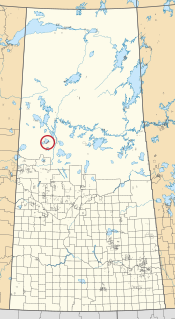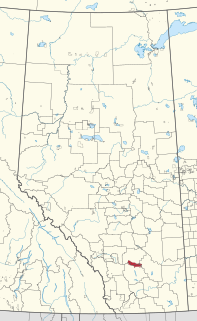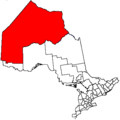
Angling Lake/Wapekeka Airport is located 1.5 nautical miles west of the First Nations settlement of Wapekeka, Ontario, Canada, to the east of Big Trout Lake and on the south shores of Weir Lake.

Gordon 86 is a Cree reserve in Saskatchewan, Canada located 61 kilometres (38 mi) northwest of Fort Qu'Appelle. Also known as the George Gordon Reserve, it is one of three territories of the George Gordon First Nation, as arranged by the signing of Treaty 4. The reserve has an area of 14,438.3 hectares. In the 2016 Canadian Census, it recorded a population of 837 living in 218 of its 238 total private dwellings. In the same year, its Community Well-Being index was calculated at 52 of 100, compared to 58.4 for the average First Nations community and 77.5 for the average non-Indigenous community. It is almost completely surrounded by the rural municipality of Touchwood No. 248.

The Oji-Cree are a First Nation in the Canadian provinces of Ontario and Manitoba, residing in a narrow band extending from the Missinaibi River region in Northeastern Ontario at the east to Lake Winnipeg at the west.
Wapekeka First Nation is a First Nation band government in the Canadian province of Ontario. An Oji-Cree community in the Kenora District, the community is located approximately 450 kilometres northeast of Sioux Lookout. In January, 2008, the total registered population was 375, of which the on-reserve population was 355.

Canoe Lake 165 is an Indian reserve of the Canoe Lake Cree First Nation in the boreal forest of northern Saskatchewan, Canada. Its location is on Canoe Lake approximately thirty miles west of Beauval, within the ancient hunting grounds of the Woodland Cree. In the 2016 Canadian Census, it recorded a population of 912 living in 250 of its 273 total private dwellings. In the same year, its Community Well-Being index was calculated at 53 of 100, compared to 58.4 for the average First Nations community and 77.5 for the average non-Indigenous community. The reserve includes the settlement of Canoe Narrows.
Fort McMurray First Nation is a Cree and Chipewyan band government located near Fort McMurray, Alberta. It is a member of the Athabasca Tribal Council and a Treaty 8 nation. The Athabasca Tribal Council represents 5 First Nation bands in northeast Alberta. Fort McMurray First Nation is governed by a Chief and two councillors.
Shibogama First Nations Council, is a regional tribal council located in northwestern Ontario, Canada. Like many of the other regional councils, Shibogama is a member of the Nishnawbe Aski Nation. On September 28, 1984, the Shibogama Area Tribal Council was established at the Kasabonika Lake Band Office. In January 1985, Shibogama First Nations Council was incorporated, making it officially an organization that is controlled and governed by the Board of Directors who are the Chiefs from each of the six member First Nations.

Big Horn 144A is an Indian reserve of the Stoney Nakoda First Nation, comprising Bearspaw, Chiniki, and Wesley First Nations in Alberta, located within Clearwater County. In the 2016 Canadian Census, it recorded a population of 237 living in 44 of its 59 total private dwellings.

Devil's Gate 220 is a First Nation reserve of the Mikisew Cree First Nation in Alberta, located within the Regional Municipality of Wood Buffalo. It is 10 kilometers north of Fort Chipewyan.

Hay Lake 209 is an Indian reserve of the Dene Tha' First Nation in Alberta, located within Mackenzie County. It is 100 km (62 mi) northwest of High Level. In the 2016 Canadian Census, it recorded a population of 883 living in 247 of its 277 total private dwellings.

Montana 139 is an Indian reserve of the Montana First Nation in Alberta, located within Ponoka County. Part of the Maskwacis community, it is 24 kilometers south of Wetaskiwin. In the 2016 Canadian Census, it recorded a population of 630 living in 137 of its 143 total private dwellings.

Piikani 147, formerly Peigan 147, is an Indian reserve of the Piikani Nation in Alberta. It is located 61 km (38 mi) west of the City of Lethbridge. It has a land area of 426.992 km2 (164.863 sq mi), making it the fourth-largest Indian reserve in Canada, and lies at an elevation of 1,046 m (3,432 ft). The Canada 2011 Census reported a population of 1,217 inhabitants. It is bordered by the Municipal District of Willow Creek No. 26 on its north and east, and by the Municipal District of Pincher Creek No. 9 on its west and south. The nearest outside communities are Fort Macleod and Pincher Creek.

Siksika 146 is a First Nations reserve of the Siksika Nation in southern Alberta, Canada. It is 87 km (54 mi) southeast of Calgary at an elevation of 857 m (2,812 ft).
The Swan Lake First Nation is a Saulteaux band government located along Swan Lake in the Pembina Valley Region of Manitoba, Canada.

Montreal Lake Cree Nation is a Woodland Cree First Nation in the boreal forest of central Saskatchewan, Canada. Its reserve, Montreal Lake 106, is on the southern shore of Montreal Lake 103 km (64 miles) north of Prince Albert and 167 km (104 miles) south of La Ronge. Highway 969 passes through the village.

The Treaty Four Reserve Grounds 77 are an Indian reserve in Saskatchewan, Canada, shared by 33 band governments from Saskatchewan and Manitoba. The Reserve Grounds are located adjacent to and west of Fort Qu'Appelle. In the 2016 Canadian Census, they recorded a population of 15 living in 6 of their 8 total private dwellings.

Wapekeka 1 is a First Nations reserve in Kenora District, Ontario. It is one of the reserves of the Wapekeka First Nation.

North Star Air is a Canadian charter, passenger and cargo airline headquartered in Thunder Bay, Ontario, with secondary passenger hub in Sioux Lookout, Ontario, and cargo hubs located in Pickle Lake, Red Lake, Kapuskasing and Thompson, Manitoba. The majority of destinations served are First Nations communities, with regular service to 18 airports under "Flex Flight Passenger Service", and other regional destinations under an on-demand basis. Founded in 1997 as a floatplane operator with two DHC-2 Beaver aircraft based in Pickle Lake, the airline has grown over the years and came under new ownership in 2012. In 2015 Cargo North and North Star Air merged under the North Star banner.

Stoney 142B is an Indian reserve of the Stoney Nakoda First Nation, comprising Bearspaw, Chiniki, and Wesley First Nations in Alberta, located within the Municipal District of Bighorn No. 8. It is 48 kilometres northwest of Calgary.

Pasqua 79 is an Indian reserve of the Pasqua First Nation in Saskatchewan. It is 16 kilometres west of Fort Qu'Appelle. In the 2016 Canadian Census, it recorded a population of 517 living in 173 of its 200 total private dwellings. In the same year, its Community Well-Being index was calculated at 56 of 100, compared to 58.4 for the average First Nations community and 77.5 for the average non-Indigenous community.
















